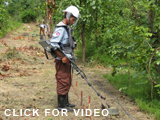





 |

The 2020 edition of the US Department of State publication “Walk the Earth in Safety” reports Zimbabwe has dense anti-personnel minefields along its borders with Mozambique and Zambia. Additionally, the Rhodesian army created an inland minefield with very dense anti-personnel mines (5,500 mines per km of frontage). Over time a second belt of “ploughshare” directional fragmentation mines were laid and protected by anti-personnel mines. Besides killing and injuring civilians, they constrain economic development particularly by killing livestock and preventing agriculture. The Zimbabwe Mine Action Center (ZMAC) reported 62km2 (13,320 acres) of contamination at the end of 2016.
Zimbabwe (formerly Rhodesia) remains contaminated with primarily anti-personnel landmines more than 30 years after its war of liberation in the 1970s.
ZIMAC reports that antipersonnel mines continue to have a humanitarian as well as a socio-economic impact in 2017, most severely affecting poor, rural populations living along heavily mined border areas. Mines continued to separate relatives living on both sides of minefields, deny use of agricultural land, kill and injure livestock and impede access for grazing, halt the productivity of areas of commercial farming, and impel some poor communities to take unacceptable risks to use contaminated land. The threat to livestock is particularly severe and with a heavy socio-economic impact as livestock is a major investment commodity in rural mine-affected areas in Zimbabwe.
Three US Humanitarian Demining Research and Development (HD R&D) Program demining technologies are undergoing evaluation in Zimbabwe; the Handheld Standoff Mine Detection System (HSTAMIDS), the Wet Soil Bucket and the Armored Remote Control Chase Vehicle, all three with The HALO Trust. Another evaluation with the Norwegian People’s Aid with HSTAMIDS took place from 2014 to 2016. HD R&D Program technologies have cleared 10,340 mines and 792,845 square meters of land to date.
Sources: To Walk the Earth in Safety, 2023
Landmine Monitor Report, 2020
|
|
HSTAMIDS |

|
The Handheld Standoff Mine Detection System (HSTAMIDS) is the U.S. Army`s AN/PSS-14 dual sensor, handheld mine detector that combines an electromagnetic induction sensor and ground penetrating radar (GPR) to detect landmines. The addition of the GPR significantly reduces the detector`s false alarm rate and the time the operator spends investigating clutter, increasing the operator`s speed and effectiveness. The HD R&D program also developed the HSTAMIDS F3S variant which incorporates a more sensitive metal detector to improve performance against deeply buried low metal anti-personnel and anti-tank mines.
Distribution Statement A: Approved for public release.



PARTNERS: The Halo Trust in Afghanistan, Cambodia, Mozambique (2012-2014), Kosovo,Sri Lanka and Zimbabwe; Mines Advisory Group in Angloa and Cambodia; Cambodia Mine Action Centre (2009-2010); Norwegian Peoples Aid in Zimbabwe (2014-2016)
|
|
    
|
|

